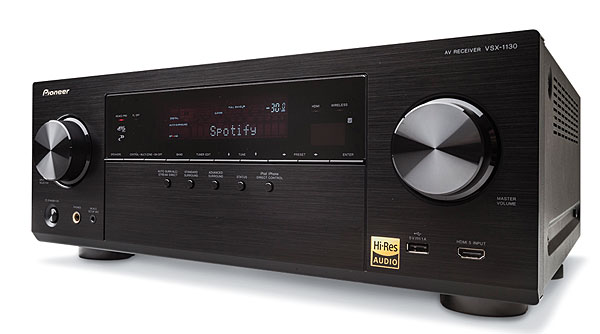Pioneer VSX-1130 A/V Receiver Review Page 2
 Room Correction: Yea or Nay?
Room Correction: Yea or Nay?
Shorn of its room correction, the VSX-1130 is an excellent amplifier, albeit a cut below the very best.
It’s a little soft-focused, and no dynamic champion, but it does make well-recorded music sound good. With MCACC Pro, imaging leaps into higher relief and timbral details emerge from the murk, though at the expense of some listening comfort. This isn’t unusual; most room EQ systems have this effect in my room.
The Hobbit: The Battle of the Five Armies (DTS-HD Master Audio) won the Pioneer its usual points for intelligible dialogue and soundfield consistency. Although the effects could be scorching, MCACC delivered them with so much focus and detail that I was able to play the movie at moderate levels without missing any dialogue, even the sotto voce kind. A more capable receiver might have delivered more complex layering in the face of dynamic peaks, but this presentation worked—until I got to the climactic five-army battle. At that point, fatigue set in. Turning down the volume was one solution, but this reduced the movie’s epic scale. A better solution was to switch out MCACC in favor of the pure direct mode, trading crispness and detail for a gentler tonal balance and greater listening ease.
In less militarized surround epics, the receiver and its room correction system were more consistently satisfying. Lucy (DTS-HD Master Audio) is a stylish sci-fi thriller from Luc Besson with an A-list cast, including Scarlett Johansson and Morgan Freeman. MCACC’s four-band sub EQ shaped the synth bass into a gorgeous and satisfying harbinger of hell about to break loose. Great bass gives me a great feeling, and MCACC’s sub EQ got along well with the Paradigm Seismic 110. (Incidentally, the sub comes with its own PBK EQ scheme, but I always keep it out of the loop and let receiver room correction do the work.) Whereas most other orchestral scores are string-heavy, this one gives the woodwinds and brass their moments of prominence in the soundfield, and MCACC shaped their textures brilliantly. I pined for the pure direct mode a bit less.
American Sniper (Dolby TrueHD/Atmos) was the feature-length Dolby Atmos demo. Even with the Atmos height channels pushed to higher levels, it was usually hard to discern them at work. A helicopter back-to-front flyover filled them when it zoomed from the surround speakers to the front speakers—but if I hadn’t been listening for it, I undoubtedly would have missed it. The Atmos “virtual dome” didn’t exactly collapse from front to back; the front just seemed slightly bigger. Naturally, I topped off the Atmos demo with Dolby’s own demo disc, noting how the perception of many of the vertical pans were limited to the front of the soundfield. With two height channels, it was still subjectively enjoyable, but not as straightforwardly impressive as what I’ve heard with four. I came to the conclusion that the appeal of 5.1.2 isn’t as strong as the 5.1.4 that Dolby recommends, at least when used with ceiling-firing Atmos-enabled speakers. I’ll defer to other reviewers on whether 5.1.2 works with physical ceiling speakers. [Ed. Note: For more on this, see “Dolby Atmos vs. Dolby Atmos” in our September issue and at soundand- vision.com.]
Viola and Vibes
In a boon to music lovers, the London Symphony Orchestra is releasing multichannel SACDs on its own LSO Live label (in addition to 96/24 FLAC via lsolive.lso.co.uk). Two works by Berlioz, the symphony Harold en Italie and the cantata La mort de Cléopâtre, feature conductor Valery Gergiev, violist Antoine Tamestit, and mezzo-soprano Karen Cargill. As beautifully recorded content sometimes does, this SACD flattered the receiver in any mode, though I still found myself torn. With MCACC, the symphony’s solo viola came through with more woody body and better articulation. Without MCACC, both viola and orchestra lost some front-row tone color, but greater depth provided more of a real concert-hall feel. Some piercing piccolo tipped the decision in favor of the pure direct mode.

Moving from multichannel SACD to mono CD (with excellent production circa 1954), I cued up Miles Davis and the Modern Jazz Giants. Except for one track featuring John Coltrane, most of the album complements the leader’s trumpet with Milt Jackson’s vibes and Thelonious Monk’s piano—an inspired combination. While Davis himself sounded great in any mode, the vibes clearly benefitted from room correction, taking on a dramatically and deliciously longer decay. The piano, seemingly miked at a greater distance than on Monk’s own albums, also took on more rhythmic incisiveness. Switching to direct mode (with bass management) or pure direct (without) made the whole thing fall flat. Chalk up one for MCACC.
I auditioned Richard Thompson’s Still twice, running the NPR First Listen stream on iPad via Bluetooth. Without room correction, it seemed crude, which I attributed to lossy streaming and Bluetooth’s own limitations, as opposed to Jeff Tweedy’s creative production. But when I switched on the room correction, the album came alive, with vivid tone color, tight imaging, and what I can only describe as a quantum leap in musicality. It was as if someone had switched on a light. Chalk up another one for MCACC.
Pioneer receivers have traditionally combined strong performance with smart but not inspiring feature sets, suggesting that the brand cares more about sound than about jamming the most stuff into one black box. In a turnaround, the VSX-1130 competes more compellingly on features than on performance, though performance is still excellent. Dolby Atmos and adapter-free Wi-Fi, AirPlay, and Bluetooth are only the most prominent of those features; I think Pioneer’s peerless app and Web-browser interface add just as much, if not more, to the attractiveness of this receiver. Pioneer has done it again, albeit not in the way I’d expected.
























































